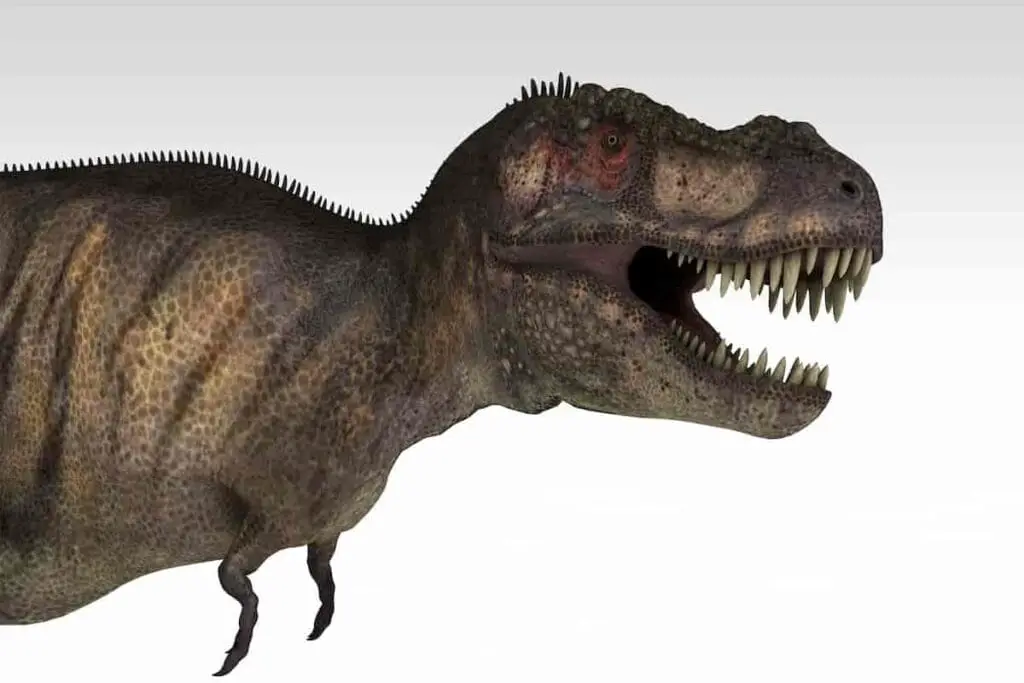The Tyrannosaurus rex is widely known as one of the most iconic dinosaurs that roamed the face of the Earth. As much as the other dinosaurs and other animals fear its presence, one part of its massive and scary body is often the source of ridicule for the species: its pair of small and short arms. It makes me wonder, what were they used for, and were they strong?
Why do Tyrannosaurus rex have small arms? In general, its short arms are used for purposes ranging from hunting prey, gripping the hunted animals, and mating. Scientists have differing theories about the size and evolution of the arms on T. Rex.
This article will tell you everything you must know about why the T-rex has small and short arms. You will also learn the different uses of their arms, the different theories scientists have concerning their arms, and the anatomy of their short and small arms. You will also learn about their arms’ hidden strength and other dinosaurs who share the same characteristics.
Did The T-Rex Have Short Arms? What Do Scientists Think They Were Used For?
Many scientists have speculated that the T-rex has short arms, but they were not initially intended to be like that. Here are some of their opinions and theories.
Their Short Arms Are As Vicious As Them
With an average body weight of six tons and the ability to tear off 500 pounds with its huge jaw, the Tyrannosaurus rex is renowned as one of the terrifying beasts to have ever lived.
[playht_player width=”100%” height=”90px” voice=”en-US-Wavenet-J”]However, one researcher suggests the T. rex’s most reviled body feature, its tiny, minuscule arms, may have been just as deadly. T. rex arms were employed to slice prey in close proximity to the dinosaur, according to Steven Stanley, a well-known paleontologist at the University of Hawaii at Manoa.

The arms had crescent-shaped claws that could inflict deadly wounds on victims and were around three feet long. Given the T. rex’s skull size, the short arm length was actually better for slashing. (Source)
T. rex’s short, powerful forelimbs and massive claws would have allowed it to deliver four puncture wounds a meter or more long and several centimeters deep in a matter of seconds, whether perched on a victim’s back or holding it with its jaws. (Source)
It was Stanley reporting at a Geological Society of America meeting in October 2017. He believes it might have happened several times in a short time.
Still Very Useful Despite Its Short Size
T. rex arms were once thought to be little more than holdovers from the predator’s development, similar to wisdom teeth in humans or wings in flightless birds. However, several facts led Stanley to believe that the arms of the ancient era’s most powerful predator may have been helpful.
Aside from the T. rex’s arm length being practical, Stanley stated that the dinosaur’s skull was part of an “unusual quasi-ball-and-socket joint” that allowed the arms to move freely. He also claimed that the little limbs were powerful, compared to the length and width of a six-foot man’s legs.
YouTube Video About Tyrannosaurus Rex’s Arms
YouTube video by Henry The Paleo Guy that discusses some theories of T. Rex arms and their usage – AdventureDinosaurs
Even with fresh information on the T. rex’s formidability, many still disagree with Stanley’s conclusions.
According to National Geographic, the arms were most likely employed for mating rather than fighting prey, according to Dr. Jakob Vinther, a paleobiologist at the University of Bristol. It appears irrational to him to cut with such little arms, according to him. (Source)
According to Thomas Holtz, a tyrannosaur expert at the University of Maryland, College Park, the arms might be a devastating weapon, which could aid in hunting sauropods. But the question is still why are t rex arms so small if used to attack prey.
However, the length and location of the limbs would force the T. rex to “essentially shove its chest up against the victim’s side,” as he told National Geographic. According to Holtz, the T. rex would have attacked using its strongest weapon, its jaws, rather than its arms.
❖ Read Now! The Ultimate Guide to Tyrannosaurus Rex
The main article in the series, it is packed with information all about the King of the Dinosaurs. it provides information about the first discovery, some of the latest fossil findings, and covers the anatomy of the dinosaur. Following this, it provides a look at the classification and phylogeny. The places, where T. Rex fossils have been found are described and a few of the key fossil skeletons are described. The master article also covers:
—Interesting facts you may not know about T. Rex
—Unanswered questions about the T. Rex
—Links to the Series Articles (17 in total!) which give deeper info on the dinosaur.
In any case, the discovery that the T. rex possessed another possible weapon is the latest in a long line of recent T. rex findings, providing cause to assume that there’s still more to learn about one of history’s biggest predators.
More On The Uses Of The Tyrannosaurus Rex’s Arms
How did T. Rex utilize its arms, given their unusually wide range of usefulness and small size? Many inquiries and investigations into the matter have resulted in a few possible theories over the years. All or some of these theories may be true.
Given how little we know about dinosaur sex right now, this is a risky endeavor. If it was knocked off its feet during combat, say, with an enthusiastic Triceratops, which may be a tough prospect if you weigh eight or nine tons, or if it slept in the same prone posture, T. Rex used its arms to push itself off the ground.
T. Rex also used its arms to grip its victims tightly before delivering a vicious bite with its teeth. The strong arm muscles of this dinosaur offer support to this theory, but we cannot find any concrete fossil proof for its activity.
The Arms – How Strong Were They And How Big Were They Comparatively?
By understanding how scientists use their arms, we can analyze how their lifestyles have affected the anatomy of their arms.
The Real Deal About The Anatomy Of The Arms
The T-Rex arm is poorly suited to its size when compared to current bipeds. Theropods with smaller forelimbs, such as raptors, have a greater reach, but spinosaurids have more powerful forelimbs. Most of us were left wondering why Mother Nature gave the tyrant lizard monarch such ridiculous limbs.
Nature, after all, is frugal: it is doubtful that theropod dinosaurs’ small arms would have survived into the late Cretaceous period if they did not serve some use. People were well aware that animals had specific appearances for a purpose. They change according to their purpose, and those arms might have been used for anything.
The arms of a T-Rex are quite tiny. Sue, the biggest T-Rex, stands 12 feet tall and towering above several theropods. She will easily dwarf many modern-day land animals at 40 feet long. In comparison to the total size of a T-rex, the arms are just 3.3 feet long. Most therapods currently have tiny arms, except for a few, such as the spinosaurids, which have large arms.
Raptors have extended arms with big claws that are decorated with feathers. The arms of abelisaurids, which include the Carnotaurus, are so tiny that they were essentially vestigial body components.
Therapods’ shorter arms in comparison to their hind legs may be explained simply by their bipedal movement. The size of the arms, however, will be determined by the dinosaur’s lifestyle.
More About The Lifestyle And Their Arms
To handle fish, Spinosaurids presumably need big arms. On the other hand, Raptors might have utilized their forelimbs for climbing or basic flapping as they pounced on their prey.
On the other hand, T-Rex had little need for its arms due to its huge and frightening skull. When the animal struck, the head was the first to strike, delivering a vicious bite. The jaws and fangs are sufficient as a weapon, and the arm has become redundant.
The most extreme example in this regard was the two-ton Carnotaurus, whose arms and hands were nubbin-like; even so, this dinosaur would have required its stunted limbs to at least lift itself off the ground if it fell down.
T-Rex limbs are not quite as deteriorated as Carnotarus’ vestigial arm. It is, in fact, still fully working. In the hind limbs of the Carnotaurus, there is not much left. Carpalia and claws may be missing from the hand. Carnotaurus arms may be analogous to the non-functional wings of emus and kiwis due to a lack of nerve for stimulation.
T-rex arms are unique. The tyrant lizard king’s total arm structure will be covered later, but it possessed powerful arms for its size to gain a better understanding. The bones are strong, and the fingers have big claws, whereas vestigial arms do not. These imply that the arms may, after all, be utilized for anything. What it may be will be discussed further down.
Theories Surrounding The T-Rex And Its Short Arms
When discussing the different theories surrounding the short arms of the T-rex and its uses, we have to get used to seeing the word “vestigial” more often. On the other hand, when talking about T. Rex’s arms, it is crucial to consider that the term “vestigial” is subjective.
A genuinely vestigial structure is one that once had a role long back in an animal’s evolutionary history but has since been reduced in size and functionality as an adaptive reaction to millions of years of evolutionary pressure.
The remains of five-toed feet that may be seen in snake skeletons are perhaps the greatest example of true vestigial architecture, which is how naturalists realized that snakes evolved from five-toed vertebrate ancestors.
However, it is also uncommon for biologists or paleontologists to label a structure as “vestigial” merely because they have yet to determine its function.
Take, for example, our appendix. Until it was found that the appendix can “reboot” the bacterial colonies in our intestines after they have been wiped out by illness or some other catastrophic event, it was considered to be the quintessential human vestigial organ. (Source)
This evolutionary benefit likely compensates for the human appendix’s tendency to become diseased, culminating in life-threatening appendicitis.
Tyrannosaurus Rex’s arms are similar to our appendices. T. Rex’s strangely shaped arms are most likely because they were precisely as large as they were required to be.
If it did not have any arms, it would not have been able to marry and create young T. Rexes that would not be able to get it up if it dropped to the ground. Also, it would not be able to pick up little, trembling ornithopods and keep them close enough just to bite off their heads.
Other Dinosaurs That Had Arms, Plus How Big Were Their Arms Compared to T. Rex?
Thankfully, the T-rex is not alone in this seemingly lonely struggle. There are other species of dinosaurs that have the same short and small arms as the T-rex, including a discovery as late as 2016.
The T-rex Is Not Alone In The Struggle
Even though the T-rex is the most famous dinosaur with short arms, other dinosaurs share the same trait as the T-rex.
Many theropods, or two-legged predatory dinosaurs linked to birds, had tiny arms, notably Carnotaurus, which had unusually weak limbs, and now another dinosaur may be added to the list. Additionally, raptor dinosaurs like Utahraptor had small arms, which begs the same question why are t rex arms so small.
Researchers reveal the finding of a completely new dinosaur that had strangely small arms given its size and was not linked to T. rex in an article published in PLOS One in July 2016. Gualicho shinyae, on the other hand, evolved the small arms on its own.
Gualicho shinyae was approximately the size of a polar bear but with the arms of a little child. Like Tyrannosaurus rex, the dinosaur is known to have two fingers, virtually a finger and a thumb.
More About The Gualicho Shinyae
Given their similar elements, it is not linked to the North American Tyrannosaurus rex, which grew to be the size of a bus. Gualicho shinyae does, however, have several recognized relatives. It is said to have a close resemblance to dinosaurs that formerly roamed Africa.
The researchers aim to learn more about the animals that evolved these small forearms to find out why that form arose in the first place. A few ideas include the possibility that the limbs were used to grasp prey or as part of a courtship ritual, but no one knows for sure.
The Gualicho, according to co-author of the article and The Field Museum’s Curator of Dinosaurs Peter Makovicky, is a mosaic dinosaur with characteristics seen in many types of theropods.
He also stated that it is unique and distinct from the other carnivorous dinosaurs discovered in the same geological formation. It does not fit easily into any of the categories.
Researchers from Chicago’s prime institution for dinosaurs, the Field Museum of Natural History, discovered the fossil in Patagonia in 2007. The principal fossil preparator of The Field Museum, Akiko Shinya, was the first to notice the fossil.
Shinya and Gualicho, a spirit of wickedness or downright nastiness in the Tehuelche civilization of Patagonia, are the names given by the researchers to the fossils.
Other Dinosaurs In The Same Team As The T-Rex
Despite its huge, muscular shoulder blade, Carnotaurus’ arm was nothing more than a stub that would have scarcely protruded from its torso. Carnotaurus was not alone in having absurdly small forelimbs, according to a new fossil discovery from Madagascar.
Carnotaurus belongs to the abelisaurids, a group of theropods. Among them were huge carnivores that roamed the Cretaceous world’s southern reaches, such as Madagascar’s Majungasaurus.
The debut broadcast of the sensationalistic program Jurassic Fight Club gave this dinosaur a temporary spike in popularity.
It is another large carnivore with unusual skull adornment. Majungasaurus possessed vestigial limbs, as researchers Sara Burch and Matthew Carrano revealed in a new Journal of Vertebrate Paleontology article.
A typical trait of abelisaurids is their small arms. Majungasaurus was thought to share this trait with other closely linked dinosaurs. Still, paleontologists could not observe what this animal’s forelimb looked like due to a lack of fossil records.
Paleontologists unearthed a fairly full and mostly articulate Majungasaurus skeleton in 2005, which included components from the whole forelimb and shoulder girdle. A furcula, or wishbone, was discovered among the items. It will be the first this bone has been discovered in an abelisaurid.
When considered as a whole, this animal’s forelimbs resemble an evolutionary joke. The upper arm is made up of a long humerus that links to a broad shoulder girdle, while the lower arm—from the radius and ulna down to the dinosaur’s four fingers—is made up of small, sturdy bones that form less than a third of the length of the arm bone. Furthermore, the fingers were stubby, short, and missing sharp claws. s
Conclusion
The Tyrannosaurus rex’s short arms are not to be seen as a flaw. Even though their arms are shorter compared to the other species of dinosaurs, they are still seen as formidable species that can easily end the lives of anyone who blocks their path. Their arms are small yet terrible.
As to why they have these arms, it is still a mystery, and it will take more years of painstaking research and studies to find out the real and complete reason behind their short arms with surprising strength. One of the T.rex’s weaknesses is its speed in movement.

